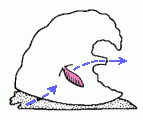Helcionellid
| Helcionellid Temporal range: Early Cambrian–Early Ordovician | |
|---|---|
| | |
| Latouchella costata restored as a gastropod | |
| Scientific classification | |
| Kingdom: | Animalia |
| Phylum: | Mollusca |
| (unranked): | incertae sedis |
| Class: | †Helcionelloida |
| Subclass: | †Archaeobranchia |
| Order: | †Helcionelliformes Geyer, 1994[1] |
| Subgroups | |
| Synonyms | |
|
Helcionelliformes Golikov & Starobogatov, 1975 | |
The Helcionellids are fossil shells of very small marine mollusks that are preserved as shells. These animals are first found about 540 to 530 million years ago in the late Nemakit-Daldynian age, which is the earliest part of the Cambrian period. A single species persisted to the Early Ordovician.[2][3][4][5] These fossils are component of the small shelly fossils (SSF) assemblages.[2]
These are thought to be early molluscs with rather snail-like shells. They may be the ancestors of the modern conchiferans, a group that includes all the well-known modern families – gastropods, cephalopods and bivalves.[6][7] Shelled molluscs therefore predate the earliest fossil trilobites.[8] They have also been considered to represent direct ancestors to the cephalopods.[9]
Parkhaev (2006, 2007) considers these animals to be crown-group gastropods. Previous to the 2006 classification by Parkhaev, helcionellids were classified within the separate class Helcionelloida or as "Uncertain position (Gastropoda or Monoplacophora)" within "Paleozoic molluscs of uncertain systematic position" according to the taxonomy of the Gastropoda by Bouchet & Rocroi, 2005[10]
2006-2007 taxonomy
According to the opinion of P. Yu. Parkhaev[11][12] the order Helcionelliformes is within the subclass Archaeobranchia Parkhaev, 2001 in the class Gastropoda.
Order Helcionelliformes Golikov & Starobogatov, 1975
- Superfamily Helcionelloidea Wenz, 1938
- Family Helcionellidae Wenz, 1938
- Family Igarkiellidae Parkhaev, 2001
- Family Coreospiridae Knight, 1947
- Superfamily Yochelcionelloidea Runnegar & Jell, 1976
- Family Trenellidae Parkhaev, 2001
- Family Yochelcionellidae Runnegar & Jell, 1976
- Family Stenothecidae Runnegar & Jell, 1980
- Subfamily Stenothecinae Runnegar & Jell, 1980
- Subfamily Watsonellinae Parkhaev, 2001
Description

Helcionellids have a single shell, in which the peak forms a distinctive curve.[13] Some have horizontal inhalent siphons[9] ("exhaust pipes") on the concave edges of their shells, and there is debate about whether these pointed forwards or backwards.[8] Most Helcionellid fossils that have been collected are only a few millimeters long and rather snail-like. However specimens a few centimeters long have also been found, mainly limpet-like in shape, although some were laterally compressed and others were tall. The smallest specimens may have been juvenile or larval forms of the larger specimens.[13]
References
- ↑ Christian B. Skovsted; John S. Peel (2007). "Small shelly fossils from the argillaceous facies of the Lower Cambrian Forteau Formation of western Newfoundland". Acta Palaeontologica Polonica. 52 (4): 729–748.
- 1 2 Budd, Graham E (2003). "The Cambrian Fossil Record and the Origin of the Phyla" (Free full text). Integrative and Comparative Biology. 43 (1): 157–165. doi:10.1093/icb/43.1.157. PMID 21680420.
- ↑ Michael Steiner; Guoxiang Li; Yi Qian; Maoyan Zhu; Bernd-Dietrich Erdtmann (2007). "Neoproterozoic to early Cambrian small shelly fossil assemblages and a revised biostratigraphic correlation of the Yangtze Platform (China)". Palaeogeography, Palaeoclimatology, Palaeoecology. 254: 67–99. doi:10.1016/j.palaeo.2007.03.046.
- ↑ Gubanov, Alexander P.; Peel, John S. (2003). "Latest Helcionelloid Molluscs from the Lower Ordovician of Kazakhstan". Palaeontology. 44 (4): 681–694. doi:10.1111/1475-4983.00198.
- ↑ Peel, John S.; Radvan J. Horný (2004). "A new problematic Early Ordovician univalve mollusc from France". Palaeontology. 47 (6): 1629–1639. doi:10.1111/j.0031-0239.2004.00414.x.
- ↑ Peel, J.S.; the Significance of Problematic Taxa (1991). "Functional morphology of the Class Helcionelloida nov. and the early evolution of the Mollusca". In Simonetta, A.M.; Conway Morris, S. The Early Evolution of Metazoa. Cambridge University Press. pp. 157–177. ISBN 0-521-40242-5. Missing
|last2=in Authors list (help) - ↑ Gubanov, A.P.; Peel, J.S. (November 2003). "The early Cambrian helcionelloid mollusc Anabarella Vostokova". Palaeontology. 46 (5): 1073–1087. doi:10.1111/1475-4983.00334.
- 1 2 3 Runnegar, B.; Pojeta Jr, J. (Oct 1974). "Molluscan Phylogeny: the Paleontological Viewpoint". Science. 186 (4161): 311–317. Bibcode:1974Sci...186..311R. doi:10.1126/science.186.4161.311. JSTOR 1739764. PMID 17839855.
- 1 2 Webers, G. F.; Yochelson, E. L. (1989). "Late Cambrian molluscan faunas and the origin of the Cephalopoda". In Crame, J. A. Origins and Evolution of the Antarctic Biota. 47. Geological Society, London: Special Publications. p. 29. doi:10.1144/GSL.SP.1989.047.01.04.
- ↑ Bouchet P. & Rocroi J.-P. (Ed.); Frýda J., Hausdorf B., Ponder W., Valdes A. & Warén A. 2005. Classification and nomenclator of gastropod families. Malacologia: International Journal of Malacology, 47(1-2). ConchBooks: Hackenheim, Germany. ISBN 3-925919-72-4. ISSN 0076-2997. 397 pp. http://www.vliz.be/Vmdcdata/imis2/ref.php?refid=78278
- ↑ P. Yu. Parkhaev (2006). "Adaptive radiation of the Cambrian helcionelloid mollusks (Gastropoda, Archaeobranchia)". In S.V. Rozhnov. Evolution of the biosphere and biodiversity. Towards the 70th anniversary of A. Y. Rozanov (pdf). Moscow. pp. 282–296.
- ↑ P. Yu. Parkhaev (2007). "The Cambrian 'basement' of gastropod evolution". Geological Society, London, Special Publications. Geological Society. 286: 415–421. Bibcode:2007GSLSP.286..415P. doi:10.1144/SP286.31. ISBN 978-1-86239-233-5.
- 1 2 Mus, M. M.; Palacios, T.; Jensen, S. (2008). "Size of the earliest mollusks: Did small helcionellids grow to become large adults?". Geology. 36 (2): 175. doi:10.1130/G24218A.1.